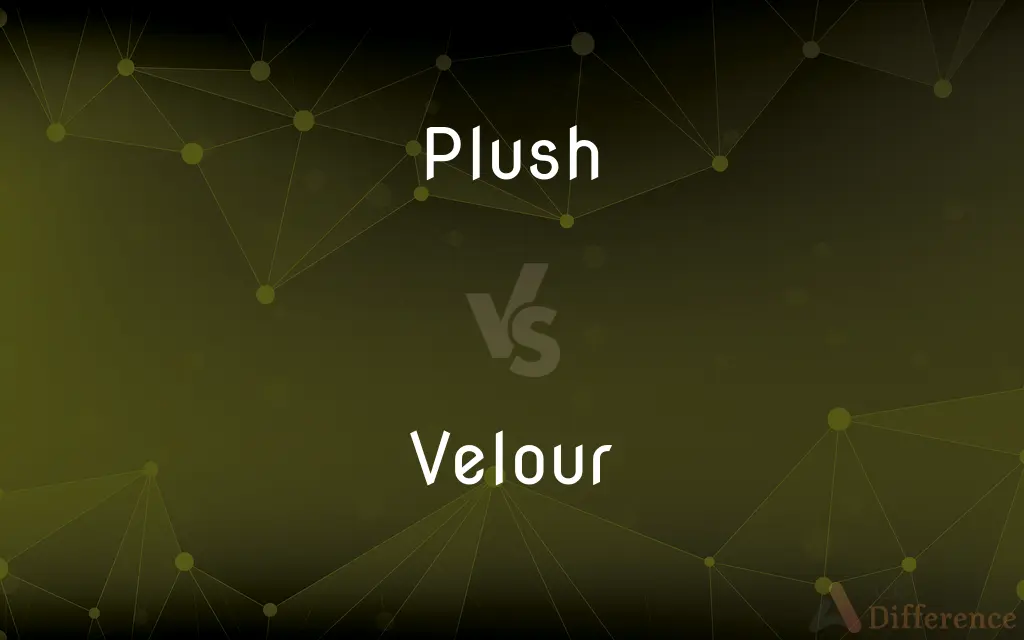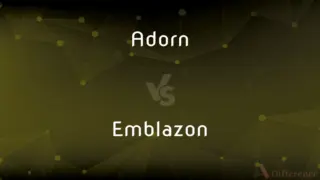Plush vs. Velour — What's the Difference?
Edited by Tayyaba Rehman — By Maham Liaqat — Updated on April 22, 2024
Plush is a soft fabric known for its deep pile and luxurious feel, often used in toys and upholstery, while velour is a knit fabric with a similar texture but more stretch, commonly used in clothing and decor.

Difference Between Plush and Velour
Table of Contents
ADVERTISEMENT
Key Differences
Plush features a long, soft pile that gives it a luxurious and fluffy appearance, making it ideal for comfort-oriented products like stuffed animals and cozy blankets. On the other hand, velour, although similarly soft, is a knit fabric which allows it to stretch, thus it's preferred in apparel like tracksuits and robes that benefit from elasticity.
The production of plush involves weaving with fibers like cotton, polyester, or wool, which are then cut to create a pile. This results in a denser and often heavier fabric. Whereas velour is typically made by knitting, which inherently gives the fabric more flexibility and a lighter feel, making it suitable for draping and body-hugging garments.
Plush is generally sturdier due to its woven structure, which makes it suitable for items that require durability like furniture upholstery. Velour, with its stretch and give, is less durable but offers greater comfort and movement, ideal for everyday wear.
In terms of care, plush can be more challenging to maintain as its thick pile can trap dirt and dust. It often requires professional cleaning, especially when used in upholstery. Velour, on the other hand, is usually easier to care for, often washable at home, making it a practical choice for active wear and casual home textiles.
When considering aesthetics, plush often has a richer and more opulent look due to its dense pile, which reflects light uniquely. This makes it popular in decorative contexts. Velour, while also having a luxurious sheen, tends to have a more casual look because of its knit texture and flow.
ADVERTISEMENT
Comparison Chart
Texture
Deep, soft pile.
Soft pile with a velvety feel.
Fabric Type
Woven, non-stretch.
Knit, stretchable.
Common Uses
Toys, upholstery.
Clothing, decor.
Durability
High, due to dense weaving.
Lower, due to knit flexibility.
Maintenance
Often requires professional cleaning.
Generally machine washable.
Compare with Definitions
Plush
Luxurious texture.
Plush towels are favored for their softness and absorbency.
Velour
Stretchable material.
Velour is favored in activewear for its flexibility and softness.
Plush
Non-stretch.
Plush fabric is ideal for upholstery due to its non-stretch nature.
Velour
Common in clothing.
Velour robes are popular for their soft texture and warmth.
Plush
Dense and heavy.
The plush carpet added a warm, luxurious feel to the room.
Velour
Knit fabric with soft pile.
Her velour tracksuit was both stylish and comfortable.
Plush
Used in toys.
Children love plush toys for their cuddly texture.
Velour
Casual and luxurious.
Velour upholstery gives a luxurious yet casual look to furniture.
Plush
Deep pile fabric.
The plush sofa felt incredibly soft and inviting.
Velour
Easier maintenance.
The velour curtains were easy to keep clean and maintained their look.
Plush
Plush (from French peluche) is a textile having a cut nap or pile the same as fustian or velvet. Its softness of feel gave rise to the adjective "plush" to describe something soft or luxurious, which was extended to describe luxury accommodation, or something rich and full.Originally the pile of plush consisted of mohair or worsted yarn, but now silk by itself or with a cotton backing is used for plush, the distinction from velvet being found in the longer and less dense pile of plush.
Velour
Velour or velours is a plush, knitted fabric or textile similar to velvet or velveteen. It is usually made from cotton, but can also be made from synthetic materials such as polyester.
Plush
A rich fabric of silk, cotton, wool, or a combination of these, with a long, soft nap
Plush upholstery
Velour
A closely napped fabric resembling velvet, used chiefly for clothing and upholstery.
Plush
Richly luxurious and expensive
A plush Mayfair flat
Velour
A felt resembling velvet, used in making hats.
Plush
A fabric of silk, rayon, cotton, or other material, having a thick deep pile.
Velour
A knit fabric similar to velvet, but usually somewhat coarser.
Plush
Made of or covered with plush.
Velour
Heavy fabric that resembles velvet
Plush
Luxurious.
Plush
(UK) Very extravagant.
Plush
(UK) Very expensive, or appearing expensive; opulent, luxurious.
They lived in a plush apartment complex.
Plush
Having a soft, fluffy exterior.
This plush toy is so cute and soft - I want it!
Plush
A textile fabric with a nap or shag on one side, longer and softer than the nap of velvet.
Plush
A plush toy.
Plush
A textile fabric with a nap or shag on one side, longer and softer than the nap of velvet.
Plush
A fabric with a nap that is longer and softer than velvet
Plush
Characterized by extravagance and profusion;
A lavish buffet
A lucullan feast
Common Curiosities
Where would you typically find plush and velour used?
Plush is often used in toys and heavy upholstery, while velour is popular in clothing like tracksuits and casual decor.
What is plush fabric?
Plush is a soft, woven fabric known for its deep pile and luxurious feel, often used in upholstery and toys.
Can velour be machine washed?
Yes, most velour fabrics can be machine washed, making them practical for everyday clothing and home textiles.
Can plush fabric stretch?
No, plush is typically a non-stretch fabric due to its woven nature, making it stable and durable.
What makes plush ideal for toys?
Its deep, soft pile makes plush particularly appealing for toys, providing a comforting and cuddly texture.
How does plush differ from velour in texture?
Plush has a deeper, denser pile, making it fluffier, whereas velour has a shorter, knit pile that is velvety to the touch.
What is velour fabric?
Velour is a soft, knit fabric with a pile, known for its stretch and comfort, commonly used in clothing and soft furnishings.
Does plush reflect light?
Yes, the dense pile of plush fabric can reflect light, giving it a distinctive, rich sheen.
Can velour be used in formal wear?
Yes, velour can be used in formal wear, especially for its elegant sheen and drape, adding a touch of luxury.
Is velour suitable for outdoor furniture?
Velour is less suited for outdoor furniture due to its knit structure and moisture sensitivity, preferring indoor use.
How does the durability of plush and velour compare?
Plush is more durable due to its tight weave, while velour, being knit, is less durable but offers more stretch.
How should plush be cleaned?
Plush should ideally be professionally cleaned, especially when used in upholstery, to protect its deep pile.
Is velour good for winter clothing?
Velour is excellent for winter clothing, providing warmth along with a luxurious feel and aesthetic.
Why is velour popular in sportswear?
Velour's stretchability and soft texture make it ideal for sportswear, offering comfort and flexibility during movement.
What are the environmental impacts of plush and velour?
Both fabrics can vary in environmental impact depending on the fibers used (natural vs synthetic); however, synthetic piles may contribute to microfiber pollution.
Share Your Discovery

Previous Comparison
Adorn vs. Emblazon
Next Comparison
Easily vs. EasyAuthor Spotlight
Written by
Maham LiaqatEdited by
Tayyaba RehmanTayyaba Rehman is a distinguished writer, currently serving as a primary contributor to askdifference.com. As a researcher in semantics and etymology, Tayyaba's passion for the complexity of languages and their distinctions has found a perfect home on the platform. Tayyaba delves into the intricacies of language, distinguishing between commonly confused words and phrases, thereby providing clarity for readers worldwide.















































